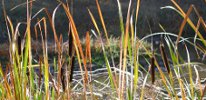
Archived Workshops/References
Modeling Nitrogen in the Elkhorn Watershed
Description
Polluted runoff is suspected as being a primary threat to the ecosystem health of the Elkhorn Slough, and agricultural areas are potentially a large source of that runoff. The Cooperative Institute for Coastal and Estuarine Environmental Technology (CICEET) and a team associated with the University of New Hampshire have developed a watershed-based tool that can help the Elkhorn Slough's watershed managers better develop management practices in agricultural areas to address nitrogen nonpoint source pollution.
The Elkhorn Slough Coastal Training Program sponsored two workshops to facilitate the transfer of this techonology to decision makers in our region. The first workshop, in 2003, focused on introducing technology that has been very accurate elsewhere in predicting the response of Nitrogen pollutants to changes in agricultural practices. The developers of this technology met with regional decision makers to discuss the potential applications for this tool and how they might gather the data necessary to develop this tool to address the Elkhorn Slough watershed.
The second workshop, in 2004, introduced the Elkhorn Slough DNDC model to the professionals who are working to address Nitrogen nonpoint source pollution. Participants were trained in the use of the model at the Moss Landing Marine Labs computer lab.
The Elkhorn Slough DNDC model is available for download in the link provided on this web page. We note that agriculture in the Elkhorn Slough Watershed is incredibly complex, with more than 40 crops and very diverse agricultural practices, slopes, and land use histories. We hope that decision makers consider this model because it has been proven elsewhere to be very effective. Much work is necessary, however, to improve this model to address the diverse cropping systems of the Elkhorn Slough and to give it truly watershed-based applicability. We encourage those who might link this model to groundwater and surface water models so that we can better link the Nitrogen of the Slough to the surrounding land use practices.
Please contact us if you would like to be trained in using this model, if you have suggestions of further trainings for Nitrogen nonpoint source pollution, or if you have questions.
Training Programs
| Modeling Nitrogen in the Watershed Workshop | May 27, 2003 - May 28, 2003 |
| Modeling Nitrogen in the Watershed, II | Jun 7, 2004 - Jun 8, 2004 |
| Utilization of Apalachicola NERR SWMP data in support of Numeric Nutrient Criteria Development for Apalachicola Bay | Oct 10, 2013 |
Documents and Publications
| TITLE DATE ADDED |
AUTHOR SOURCE |
DESCRIPTION |
|---|---|---|
| OTHER INFORMATION | ||
| A Guide to the TMDL Process PDF, 33KB Jun 30 05 |
Central Coast Regional Water Quality Control Board www.swrcb.ca.gov/rwqcb3/ Spring/Summer 2003 |
This two page document introduces the Total Maximum Daily Load (TMDL) concept - what it is and how these regulations are being developed. It also provides contact information for more information. |
Links
| TITLE | DATE ADDED |
|---|---|
| Elkhorn Slough DNDC Model http://www.dndc.sr.unh.edu/ |
Apr 20 06 |
